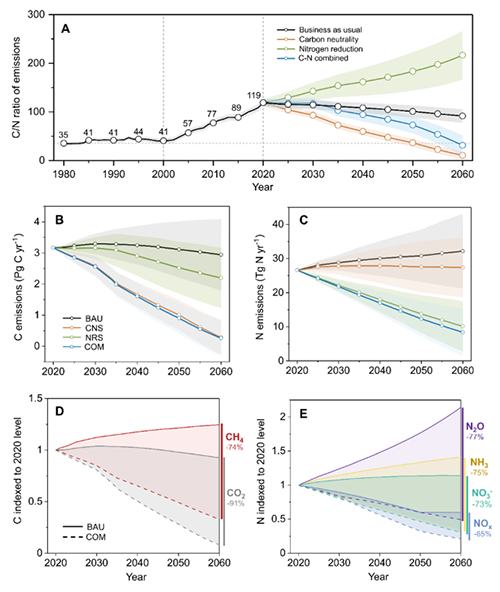Chinese Scholars and International Collaborators Make Progress in Integrated Carbon and Nitrogen Management Research

Figure. Carbon and nitrogen emissions and the carbon-to-nitrogen (C/N) ratio in China under different mitigation scenarios from 2020 to 2060
Supported by the National Natural Science Foundation of China (Young Scientist Fund-A; Grant No. 42325707), the research team led by Professor Baojing Gu from Zhejiang University, in collaboration with international partners, has achieved progress in the field of carbon and nitrogen cycle regulation. The study, titled “Integrated carbon and nitrogen management for cost-effective environmental policies in China”, was published online in Science on June 5, 2025. Paper link: https://www.science.org/doi/10.1126/science.ads4105.
Carbon and nitrogen are fundamental elements in global biogeochemical cycles, playing essential roles in maintaining soil health, supporting plant growth, and preserving biodiversity. However, the rapid increase in anthropogenic carbon and nitrogen emissions has pushed Earth systems beyond safe operating boundaries. Developing integrated carbon and nitrogen management strategies that account for multiple interfaces (such as air, soil, and water) and span across sectors (such as industry, agriculture, and forestry) is crucial for enabling China to achieve cost-effective environmental governance.
To address this challenge, Professor Gu’s team developed a Coupled Human and Natural Systems- Carbon and Nitrogen Cycles (CHANS-CN) model, which systematically maps the carbon and nitrogen flows across 16 interlinked subsystems in China from 1980 to 2020. Through multi-scenario simulations, the study assessed the mitigation potential and economic feasibility of integrated carbon and nitrogen management. By combining an extensive database of carbon-nitrogen mitigation measures with subsystem-specific coupling mechanisms, the researchers identified optimal intervention strategies and prioritized sectors for implementation.
Under China’s carbon neutrality targets, the study reveals that by 2060, integrated management could reduce carbon emissions by 91% and nitrogen emissions by 74%, while restoring the carbon-to-nitrogen (C/N) emissions ratio to a historically stable range (within 35 and 44). Compared to managing carbon or nitrogen independently, integrated management offers greater societal benefits. By 2060, the total social benefits (encompassing human health, ecosystem services, and climate benefits) are projected to be more than four times the implementation cost. Furthermore, it reduces the cost per unit of carbon-nitrogen abatement by 37%, lowering it to $3.10 per kilogram of carbon-nitrogen impact equivalent (CNIeq), demonstrating both economic and environmental advantages.
The study highlights that integrated management strategies can be tailored to regional natural resource endowments and socio-economic conditions, enabling harmonized emission reductions across spatial and sectoral scales. This also provides a scientific foundation for nature-based solutions and supports the development of flexible, multi-level environmental governance frameworks.
Contact Us

National Natural Science Foundation of China
Add: 83 Shuangqing Rd., Haidian District, Beijing, China
Postcode: 100085
Tel: 86-10-62327001
Fax: 86-10-62327004
E-mail: bic@nsfc.gov.cn
